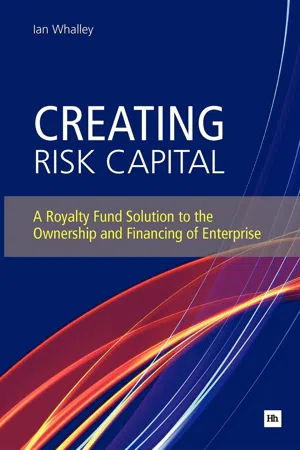
Creating Risk Capital
A Royalty Fund Solution to the Ownership and Financing of Enterprise
- 246 pages
- English
- ePUB (mobile friendly)
- Available on iOS & Android
Creating Risk Capital
A Royalty Fund Solution to the Ownership and Financing of Enterprise
About this book
Private enterprises are essential to a nation's economy and society - yet without finance, or risk capital, they may never get off the ground. Lack of risk capital on suitable terms thus frustrates entrepreneurial ambition, and checks economic growth. And, just as damaging, the search for finance can lead companies and businesses into unsuitable funding arrangements - such as bank loans or equity deals with external investors - that burden them with excessive debt or limit the ability of managers to run the business. This book proposes a fresh solution to the search for risk capital that should suit enterprise and investor alike.Ian Whalley begins by describing the rich inheritance of private enterprises and the financial systems which support them in major market economies. He looks at some serious problems which afflict many enterprises when they seek funding through conventional methods: from small and medium-size firms to major companies, providers of public services and diverse enterprises such as mutual and non-profit organisations. A common theme emerges - enterprises of all types struggle to obtain risk capital without taking on debt or compromising effective management control. The capital is necessary but the drawbacks are potentially fatal.The book shows how the dual functions of equity - risk capital and ownership capital - can be separated and thus how risk finance can be raised without affecting the ownership or control of a company, and without traditional borrowing. The model for achieving this is royalty funding, a system grounded in the proven and familiar practice of licensing. Under this system enterprises pay for the invested risk capital by means of royalties on the sales revenues they achieve, rather than become debtors or partners to those who provide the funds. Royalty funding will benefit both those who own and manage enterprises and also the investors who receive a contractually committed return whilst maintaining the security of asset ownership in the event of a failure of the enterprise.Whalley explains how royalty funding could be put into practice for a range of different enterprises, and draws some broad conclusions about the impact that royalty funding could have if used to finance business in the future.Offering a compelling alternative that complements current financial models this is an essential read for anyone involved in establishing, running or investing in successful enterprises, as well as policymakers and academics.
Frequently asked questions
- Essential is ideal for learners and professionals who enjoy exploring a wide range of subjects. Access the Essential Library with 800,000+ trusted titles and best-sellers across business, personal growth, and the humanities. Includes unlimited reading time and Standard Read Aloud voice.
- Complete: Perfect for advanced learners and researchers needing full, unrestricted access. Unlock 1.4M+ books across hundreds of subjects, including academic and specialized titles. The Complete Plan also includes advanced features like Premium Read Aloud and Research Assistant.
Please note we cannot support devices running on iOS 13 and Android 7 or earlier. Learn more about using the app.
Information
PART I. A RICH INHERITANCE
1. Enterprise and its Origins
The enterprise
Business enterprises
Rolls-Royce
Diverse enterprises
Table of contents
- Cover
- Publishing details
- Acknowledgments
- Preface
- Introduction
- PART I. A RICH INHERITANCE
- PART II. SOME PERSISTENT PROBLEMS
- PART III. A ROYALTY FUND SOLUTION
- Bibliography